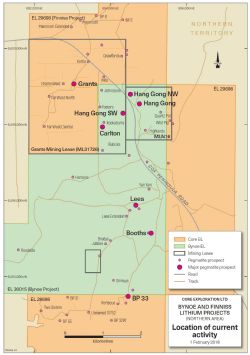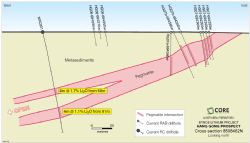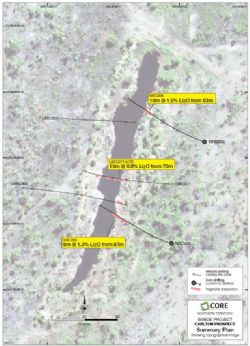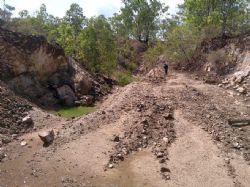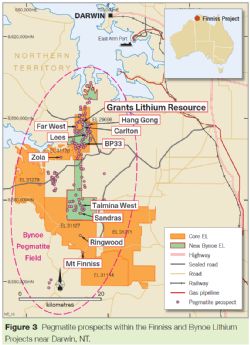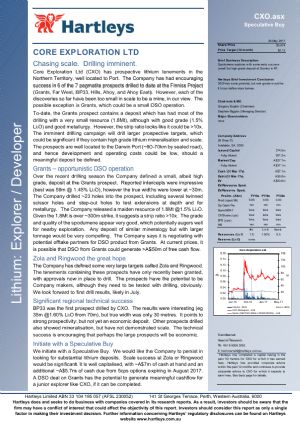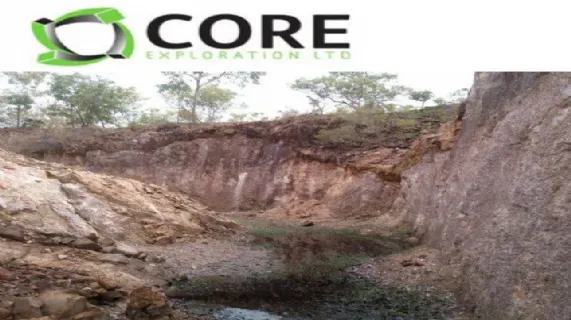 High-Grade Lithium Intersected in New Spodumene Pegmatites
High-Grade Lithium Intersected in New Spodumene Pegmatites
Adelaide, Feb 5, 2018 AEST (ABN Newswire) - Following on from its recent announcements regarding the recommencement of resource drilling at the high-grade BP33 and Grants Prospects, Core Exploration Ltd ( ASX:CXO) ("Core" or the "Company") is pleased to announce that, it has now received high grade lithium assay results from Reverse Circulation (RC) drilling that took place on adjoining tenement EL30015 (Bynoe Project) in December 2017.
ASX:CXO) ("Core" or the "Company") is pleased to announce that, it has now received high grade lithium assay results from Reverse Circulation (RC) drilling that took place on adjoining tenement EL30015 (Bynoe Project) in December 2017.
HIGHLIGHTS
- Acquisition of the Bynoe Lithium Project is continuing to deliver immediate positive results for Core, with high-grade Lithium drill assays received from all four historic pegmatite mines in Core's first drilling on the newly acquired EL30015, including:
o 10m @ 1.6% Li2O from 83m in NRC006 at Carlton prospect
o 5m @ 2.2% Li2O from 70m in NRC004 at Hang Gong prospect
o Including 1m @ 3.0 % Li2O from 70m in NRC004
- Drilling data from RC and RAB at the Hang Gong, Booths and Lees prospects indicates multiple, shallow dipping, and high grade spodumene pegmatites
- Multiple, shallow dipping pegmatites up to 20m true width provide alternate open pit mining scenarios at the Finniss Project
- All prospects drilled have grades greater than 1.0 % Li2O and are open down-dip and along strike
- Newly drilled spodumene pegmatites are located within 5km of the Grants Lithium Deposit
- Hang Gong is within granted Mining Lease ML16 and Carlton is within the Grants ML Application
- Core will commence follow up drilling of these prospects as soon as dry season starts
The recent acquisition of the Bynoe Lithium Project is continuing to deliver immediate positive results for Core. These high-grade lithium intersections are very significant, and our first drilling demonstrates the strong potential for Hang Gong and other historic prospects.
A stand-alone RC drilling campaign was carried out during December at Hang Gong, Lees, Carlton and Booths Prospects, all within the Company's newly acquired Bynoe Lithium Project near Darwin, and importantly, very close to Core's planned development of the Grant's deposit, located approximately 5kms away. The RC program was designed to investigate preliminary low-grade results obtained by the previous owner.
Core's new assay results indicate an improved grade, within spodumene pegmatites up to 20m true width, the higher grades intercepted by Core's drilling are the result of successful targeting of drill holes to intercept the pegmatites below the effects of surficial weathering.
Core's drilling has demonstrated that the pegmatites at three of these prospects (Hang Gong, Booth and Lees) comprise multiple pegmatites bodies that dip at a shallow angle.
New assay results include:
- 10m @ 1.6% Li2O from 83m in NRC006 at Carlton prospect
- 5m @ 2.2% Li2O from 70m in NRC004 at Hang Gong prospect
- 4m @ 1.4% Li2O from 72m in NRC008 at Lees prospect
- 3m @ 1.6% Li2O from 87m in NRC011 at Booths prospect
A similar high grade of mineralised intervals was observed across all four spodumene rich pegmatite prospects (approx. 1.5% Li2O at a 0.4% Li2O cutoff is consistent with the Grants Deposit). In addition, individual metre-width grades of >2% Li2O have been recognised at all four prospects, and the maximum metre-width grade being 3.0% Li2O (from 70m in NRC004 at Hang Gong).
Core also undertook a targeted shallow Rotary Airblast (RAB) drilling program at these prospects, the results of which are still being assessed, but the geological data has proven invaluable in the interpretation of pegmatite geometry and fine-tuning of the RC drill plan. For example, it has enabled the subsurface extrapolation of pegmatite bodies from surface workings to more distant, deeper drilling intersections.
Based on these result, Core is planning to drill further down-dip with the aim of defining larger footprint pegmatites that have robust mining attributes.
Commenting on drilling at Bynoe, Core's Managing Director, Stephen Biggins said:
"The acquisition of the Bynoe Lithium Project is continuing to deliver immediate positive results for Core. These high-grade lithium intersections are very significant and our first drilling demonstrates the potential of Hang Gong and other historic prospects.
The success of these results has given us the encouragement to drill further down-dip with the aim of defining larger footprint pegmatites with robust mining attributes."
Hang Gong
The successful drilling by Core supports the interpretation that Hang Gong most likely comprises a series of shallow dipping pegmatites containing grades up to 3.0% Li2O.
Hang Gong is historically the largest historic pegmatite mine in the area and several pegmatite bodies up to 20m true width and dipping at less than 30 degrees have now been identified by Core's drilling at Hang Gong (see Figure HG1 in link below).
Although the recent RAB drilling pattern suggested a large and consistent pegmatite footprint, which has never been tested by deep drilling, Core is encouraged by the results which suggest a branching high-grade spodumene pegmatite with a down-dip extent of at least 200m (4m @ 1.7% Li2O from 58m & 4m @ 1.1% Li2O from 81m in NRC001) (see Figure HG1 in link below).
Other adjacent and subparallel RAB-defined sheets have yet to be followed up and could be part of a stacked set.
Lees
Lees Prospect comprises a set of at least three parallel, approx. 10m true width, consistent pegmatite bodies, striking WNW and dipping at approximately 45 degrees to the NNE (interpreted as an en-echelon tension gash set).
Core drilled two RC holes following up the 3 drilled by the previous owners in 2016. The Company also undertook a targeted RAB program to define the geometry of the two other sheets to the south. The geometry of shallow-dipping multiple stacked pegmatites was confirmed by this drilling (see Figures LE1 and LE2 in link below).
The intersections of the northern sheet (Lees proper) include 4m @ 1.4% Li2O from 72m in NRC008 and 9m @0.9% Li2O from 97m in NRC007. Individual metre-grades encountered are up to 2.5% Li2O, despite the effects of surface weathering in some of the samples. In addition, the exposed pegmatite in the historic pits are clay-rich with uniformly-distributed relict spodumene, and have sharp country-rock contacts, similar to Grants and BP33. This supports the concept that they are potentially strongly mineralised over significant intervals down-dip in the fresh zone.
The southern pegmatites appear thicker based on the exposures in historic pits (see Figure LE3 in link below) and from RAB- drilling, but their grade has yet to be confirmed. None of the Lees prospects have been tested along strike or down plunge.
Core is planning follow-up RC drilling to test the down plunge potential at Lees (Fig LE1).
Carlton
The Carlton historic pit is over 200m long and up to 20m wide, dipping at a steep angle to the east (see Figure CA1 in link below), similar in many respects to Grants and BP33.
Drilling by previous owners in 2017 intersected low-grade weathered pegmatite over a width of up to 16m (LTR LBRC071). However, analysis of the drill logs in 3D suggested that two of the three holes drilled at the time were terminated too shallow (see Figure CA1 in link below).
Core's recent follow up drilling showed that the body contains high-grade spodumene pegmatite (10m @ 1.6% Li2O from 83m in NRC006). Narrower and lower grade intervals appear to be the result of drilling through the pegmatite in the weathered zone. Core has not yet tested down-dip or along the strike extent of this pegmatite, which appears to plunge to the north under cover.
Booths
The historically-mined Booths Prospect consists of two parallel pegmatites up to 20m wide in pit exposures and 160m in strike length. At the time drilling by previous owners in 2016 was hindered by issues, largely caused by the clay-rich nature of the pegmatite in the subsurface.
Core drilled RC holes to intersect the pegmatite at a deeper level in fresh rock which returned some wide pegmatite intervals up to 15m pegmatite in aggregate.
Exposed pegmatite in the historic pit at Booths (see Figure B1 in link below) shows ubiquitous weathered spodumene in the pegmatite right up the contacts with surrounding phyllite wall rock of the Burrell Creek Formation. Higher grades of lithium including 3m at 1.6% Li2O (from 87m in NRC0011) that were intersected in fresh zones of the pegmatites at depth are consistent with relict spodumene at surface, but weathering (and lithium related depletion) was deeper at Booths than other prospects.
The presence of two 15m-thick, closely-spaced, shallow-dipping, high-grade pegmatites at Booths is attractive as there is little historic evidence that strike extensions of these bodies have been tested, as mining was focused solely on what was exposed at surface.
Next Steps at Bynoe Project
The four pegmatite prospects outlined above have compelling characteristics - 5m-15m true width, consistent geometry, shallow dip (<45 degrees), stacked sets, inherently high grade (average 1.5% Li2O) and in very accessible location to current tracks and roads as well as being close to the proposed Grants Mine.
The newly drilled prospects will be followed up by RC and RAB drilling, both down-dip and along strike, as soon as access is possible following the wet season.
Core has shown that it can move rapidly from first drill discovery to a JORC resource in as little as 6 months.
It is important to note that the Hang Gong targets are largely contained within a granted Mining Lease and lie within 200m of the bitumen Cox Peninsula Road. The Carlton target is located within the Grants ML application close to the Grants Lithium Resource.
The RAB drilling data has yet to be fully modelled in 3D and Core is confident this will generate further leads in EL30015 and adjacent EL29698.
To view tables and figures, please visit:
http://abnnewswire.net/lnk/44C42X0D
About Core Lithium Ltd
 Core Lithium Ltd (ASX:CXO) is an Australian hard-rock lithium company that owns the Finniss Lithium Operation on the Cox Peninsula, south-west and 88km by sealed road from the Darwin Port, Northern Territory. Core's vision is to generate sustained shareholder value from critical minerals exploration and mining projects underpinned by strong environmental, safety and social standards.
Core Lithium Ltd (ASX:CXO) is an Australian hard-rock lithium company that owns the Finniss Lithium Operation on the Cox Peninsula, south-west and 88km by sealed road from the Darwin Port, Northern Territory. Core's vision is to generate sustained shareholder value from critical minerals exploration and mining projects underpinned by strong environmental, safety and social standards.

![abnnewswire.com]()
Related Companies
Social Media
Share this Article

 ASX:CXO) ("Core" or the "Company") is pleased to announce that, it has now received high grade lithium assay results from Reverse Circulation (RC) drilling that took place on adjoining tenement EL30015 (Bynoe Project) in December 2017.
ASX:CXO) ("Core" or the "Company") is pleased to announce that, it has now received high grade lithium assay results from Reverse Circulation (RC) drilling that took place on adjoining tenement EL30015 (Bynoe Project) in December 2017.  Core Lithium Ltd (ASX:CXO) is an Australian hard-rock lithium company that owns the Finniss Lithium Operation on the Cox Peninsula, south-west and 88km by sealed road from the Darwin Port, Northern Territory. Core's vision is to generate sustained shareholder value from critical minerals exploration and mining projects underpinned by strong environmental, safety and social standards.
Core Lithium Ltd (ASX:CXO) is an Australian hard-rock lithium company that owns the Finniss Lithium Operation on the Cox Peninsula, south-west and 88km by sealed road from the Darwin Port, Northern Territory. Core's vision is to generate sustained shareholder value from critical minerals exploration and mining projects underpinned by strong environmental, safety and social standards.


